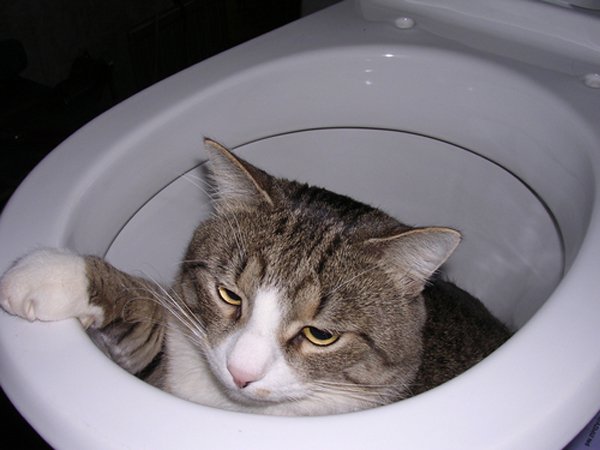Dangers of Flushing Cat Poop in Your Toilet - Preventive Steps
Dangers of Flushing Cat Poop in Your Toilet - Preventive Steps
Blog Article
This article in the next paragraphs pertaining to Don’t flush cat feces down the toilet is particularly intriguing. Don't miss out on it.

Introduction
As cat proprietors, it's vital to be mindful of exactly how we dispose of our feline good friends' waste. While it might appear convenient to flush pet cat poop down the commode, this technique can have damaging effects for both the environment and human wellness.
Environmental Impact
Flushing cat poop presents harmful pathogens and parasites into the supply of water, posturing a considerable risk to marine ecosystems. These impurities can adversely affect aquatic life and compromise water high quality.
Health and wellness Risks
In addition to environmental concerns, purging pet cat waste can likewise posture wellness dangers to human beings. Cat feces may have Toxoplasma gondii, a parasite that can cause toxoplasmosis-- a possibly serious disease, particularly for pregnant ladies and individuals with weakened body immune systems.
Alternatives to Flushing
Thankfully, there are safer and extra responsible methods to get rid of pet cat poop. Consider the adhering to alternatives:
1. Scoop and Dispose in Trash
The most typical approach of disposing of pet cat poop is to scoop it right into an eco-friendly bag and toss it in the garbage. Be sure to use a devoted clutter scoop and throw away the waste without delay.
2. Use Biodegradable Litter
Select naturally degradable pet cat trash made from products such as corn or wheat. These trashes are environmentally friendly and can be safely thrown away in the trash.
3. Bury in the Yard
If you have a yard, think about burying pet cat waste in an assigned location far from veggie gardens and water sources. Be sure to dig deep sufficient to stop contamination of groundwater.
4. Set Up a Pet Waste Disposal System
Purchase an animal garbage disposal system specifically created for cat waste. These systems make use of enzymes to break down the waste, lowering smell and ecological influence.
Final thought
Accountable animal possession expands past offering food and shelter-- it additionally entails correct waste management. By refraining from flushing pet cat poop down the toilet and going with different disposal methods, we can reduce our ecological impact and safeguard human health.
Why You Should Never Flush Cat Poop Down the Toilet
A rose by any other name might smell as sweet, but not all poop is created equal. Toilets, and our sewage systems, are designed for human excrement, not animal waste. It might seem like it couldn’t hurt to toss cat feces into the loo, but it’s not a good idea to flush cat poop in the toilet.
First and foremost, assuming your cat uses a litter box, any waste is going to have litter on it. And even the smallest amount of litter can wreak havoc on plumbing.
Over time, small amounts build up, filling up your septic system. Most litter sold today is clumping; it is made from a type of clay that hardens when it gets wet. Ever tried to scrape old clumps from the bottom of a litter box? You know just how cement-hard it can get!
Now imagine just a small clump of that stuck in your pipes. A simple de-clogger like Drano isn’t going to cut it. And that means it’s going to cost you big time to fix it.
Parasitic Contamination
Believe it or not, your healthy kitty may be harboring a nasty parasite. Only cats excrete Toxoplasma in their feces. Yet it rarely causes serious health issues in the cats that are infected. Most people will be fine too if infected. Only pregnant women and people with compromised immune systems are at risk. (If you’ve ever heard how women who are expecting are excused from litter cleaning duty, Toxoplasma is why.)
But other animals may have a problem if infected with the parasite. And human water treatment systems aren’t designed to handle it. As a result, the systems don’t remove the parasite before discharging wastewater into local waterways. Fish, shellfish, and other marine life — otters in particular — are susceptible to toxoplasma. If exposed, most will end up with brain damage and many will die.
Depending on the species of fish, they may end up on someone’s fish hook and, ultimately on someone’s dinner plate. If that someone has a chronic illness, they’re at risk.
Skip the Toilet Training
We know there are folks out there who like to toilet train their cats. And we give them props, it takes a lot of work. But thanks to the toxoplasma, it’s not a good idea.

As a person who reads about How to Dispose of Cat Poop and Litter Without Plastic Bags, I thought sharing that portion was beneficial. Are you aware of somebody else who is looking into How to Dispose of Cat Poop and Litter Without Plastic Bags? Be sure promote it. Thanks for your time invested reading it.
Click Here To Find Out More Report this page